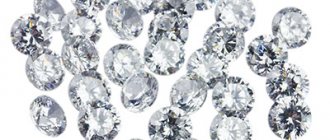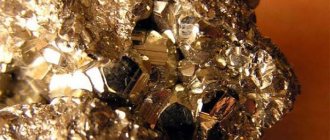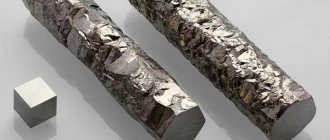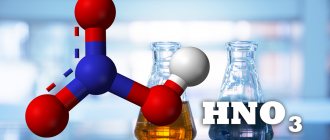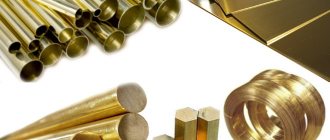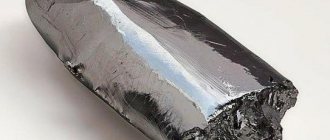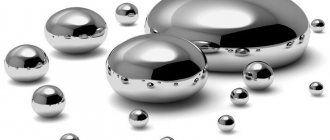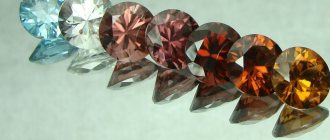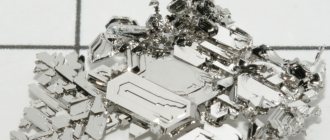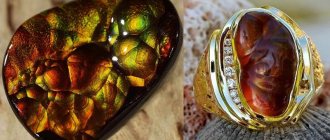Zirkaloy family
Zirconium alloys
are solid solutions of zirconium or other metals, a common divisor bearing the trademark
zircaloy
. Zirconium has a very low absorption cross-section of thermal neutrons, high hardness, ductility, and corrosion resistance. One of the main uses of zirconium alloys is in nuclear technology, as the cladding of fuel elements in nuclear reactors, especially water reactors. The typical composition of nuclear grade zirconium alloys is more than 95 wt% [1]zirconium and less than 2% tin, niobium, iron, chromium, nickel and other metals, which are added to improve mechanical properties and corrosion resistance. [2]
Water cooling of zirconium alloys in reactors increases the requirements for their resistance to nodal corrosion associated with oxidation. In addition, the oxidation reaction of zirconium with water releases hydrogen, which partially diffuses into the alloy and forms zirconium hydrides. [3] Hydrides are less dense and mechanically weaker than an alloy; their formation leads to swelling and cracking of the shell, a phenomenon known as hydrogen embrittlement. [4] [5]
Production and properties [edit]
Commercial non-nuclear grade zirconium typically contains 1–5% hafnium, which has a neutron absorption cross section 600 times that of zirconium. Therefore, hafnium must be almost completely removed (reduced to <0.02% of the alloy) for reactor applications. [2] [6]
Nuclear grade zirconium alloys contain more than 95% Zr, so most of their properties are similar to those of pure zirconium. The thermal neutron absorption cross section for zirconium is 0.18 barn, which is much lower than that of such common metals as iron (2.4 bar) and nickel (4.5 bar). [6] The composition and main applications of common reactor grade alloys are briefly described below. These alloys contain less than 0.3% iron and chromium and 0.1–0.14% oxygen. [7]
| Alloy | ,% | ,% | Manufacturer (country) | Component | Reactor type |
| Circaloy 2 | 1,2–1,7 | — | All manufacturers | Cladding, structural elements | BWR, CANDU |
| Circaloy 4 | 1,2–1,7 | — | All manufacturers | Cladding, structural elements | BWR, PWR, CANDU |
| ZIRLO | 0,7–1 | 1 | Westinghouse | Facing | BWR, PWR |
| Zr Sponge | — | — | Japan and Russia | Facing | BWR |
| ZrSn | 0,25 | — | Westinghouse | Facing | BWR |
| Zr2.5Nb | — | 2,4–2,8 | Fabrica de Aleaciones Especiales (FAE) (Argentina) | Pressure tube | KANDU |
| E110 | — | 0,9–1,1 | Russia | Facing | VVER |
| E125 | — | 2,5 | Russia | Pressure tube | RBMK |
| E635 | 0,8–1,3 | 0,8–1 | Russia | Structural Components | VVER |
| M5 | — | 0,8–1,2 | Areva | Cladding, structural elements | PWR |
*ZIRLO means ZIR
Conium
l
ow
O
xidation.
Oxidation of zirconium alloy[edit]
Zirconium alloys easily react with oxygen, forming a passivation layer up to a nanometer thick. [11] The corrosion resistance of alloys can be significantly degraded in the presence of certain impurities (for example, more than 40 ppm carbon or more than 300 ppm nitrogen). [12] The corrosion resistance of zirconium alloys is enhanced by the deliberate application of a thicker passivating layer of black, lustrous zirconium oxide. Nitride coatings can also be used.
While there is no consensus on whether zirconium and zirconium alloy have the same oxidation rate, zircaloys 2 and 4 behave very similarly in this regard. Oxidation occurs at the same rate in air or water and occurs under ambient or high vacuum conditions. A thin submicrometer layer of zirconium dioxide quickly forms on the surface and stops further diffusion of oxygen into the bulk and subsequent oxidation. The dependence of the oxidation rate R on temperature and pressure can be expressed as [13]
R = 13.9 P 1/6 exp (-1.47/k BT)
The oxidation rate R here is expressed in grams/(cm 2 sec); P - atmospheric pressure, that is, the coefficient P 1/6 = 1 at atmospheric pressure; activation energy is 1.47 eV; k B is Boltzmann's constant (8.617 × 10 - 5 eV/K) and T is the absolute temperature in Kelvin.
Thus, the oxidation rate of R is 10 -20 g per 1 m 2 area per second at 0 ° C, 6 × 10 - 8 g -2 s -1 at a temperature of 300 ° C, 5.4 mg m -2 s - 1 at 700 °C and 300 mg m -2 s -1 at 1000 °C. Although there is no clear threshold for oxidation, it becomes noticeable on a macroscopic scale at temperatures of several hundred °C.
Medical industry
When considering zirconium and its alloys, one cannot fail to mention another area of their use. In the medical industry they occupy far from the last place. Until recently, steel and titanium alloys were used to make implants and fixators. However, in some cases, the body rejected these metals, causing an allergic reaction. Modern medicine uses zirconium and titanium alloys for the manufacture of staples, plates, implants, dentures and their fixation mechanisms.
Since this metal and its compounds do not irritate bones and surrounding soft tissues, it is successfully used for making jewelry. For example, zirconium earrings do not cause an allergic reaction and heal a wound on the earlobe no worse than gold.
Oxidation of zirconium with steam[edit]
One of the disadvantages of zirconium metal is that in the event of a loss of coolant accident in a nuclear reactor, the zirconium cladding quickly reacts with water vapor at high temperatures above 1500 K (1230 °C). [14] [15] Oxidation of zirconium with water is accompanied by the release of hydrogen gas. This oxidation is accelerated at high temperatures, such as inside a reactor core, if the fuel assemblies are no longer completely covered in liquid water and are not cooled sufficiently. [16] Zirconium metal is then oxidized using protons with water to form hydrogen gas according to the following redox reaction:
Zr + 2 H 2 O → ZrO 2 + 2 H 2
A zirconium cladding in the presence of deuterium oxide D2O, often used as a moderator and coolant in the next generation of pressurized heavy water reactors such as those used in CANDU nuclear reactors, will exhibit the same oxidation when exposed to deuterium oxide steam as follows:
Zr + 2 D 2 O → ZrO 2 + 2 D 2
This exothermic reaction, although only occurring at high temperature, is similar to the reaction of alkali metals (such as sodium or potassium) with water. It is also very similar to the anaerobic oxidation of iron by water (a reaction used by Antoine Lavoisier at high temperature to produce hydrogen for his experiments).
This reaction was responsible for the small hydrogen explosion first observed at the Three Mile Island reactor building in 1979, which did not damage the containment building. The same reaction occurred in boiling water reactors 1, 2 and 3 of the Fukushima Daiichi Nuclear Power Plant (Japan) after reactor cooling was interrupted by the earthquake and tsunami of the March 11, 2011 Fukushima Daiichi nuclear disaster. . Hydrogen gas was released into the reactor maintenance rooms and the resulting explosive mixture of hydrogen and air oxygen exploded. The explosions severely damaged external buildings and at least one containment building. [17] A reaction also occurred during the Chernobyl nuclear power plant accident when steam began to escape from the reactor. [18] Many water-cooled reactor containment buildings contain passive autocatalytic recombiners based on catalysts to rapidly convert hydrogen and oxygen into water at room temperature until the explosive limit is reached.
Other applications of zirconium-based compounds and alloys
Many antiperspirants contain a component such as Aluminum Zirconium Tetrachlorohydrex. This is a chemical compound that absorbs sweat and its unpleasant odor. Scientists have found that it is not absorbed into the skin, which means it cannot cause serious harm to health. Despite this, aluminum-zirconium-tetrachlorhydrexglycine is banned in the EU and USA.
Zirconium oxide is used to make electrocorundum. It is obtained by melting in tilting electric furnaces. Zirconium electrocorundum is quite durable and allows you to process materials with high clamping force. Most often it is used for rough and rough grinding.
In general, it should be noted that zirconium and its alloys have a high melting point, resistance to chemical influences, and a low coefficient of thermal expansion. It is for this reason that it is actively used in a wide variety of fields.
Hydride formation and hydrogen embrittlement[edit]
Bright field transmission electron microscopy (TEM-BF) micrograph of zirconium hydride in the microstructure of zircaloy-4.
Additionally, 5–20% hydrogen diffuses into the zirconium alloy shell to form zirconium hydrides. [19] The hydrogen production process also mechanically weakens the shell of the rods, since hydrides have lower ductility and density than zirconium or its alloys, and thus bubbles and cracks form when hydrogen accumulates. [4] This process is also known as hydrogen embrittlement. It has been reported that the concentration of hydrogen in hydrides also depends on the site of nucleation of the precipitates. [20] [21]
In the event of a loss of coolant accident (LOCA) in a damaged nuclear reactor, hydrogen embrittlement accelerates the failure of the zirconium alloy cladding of fuel rods exposed to high temperature steam. [22]
General information
Zirconium (Zr) is an element of the periodic table whose atomic number is 40 and its atomic weight is 91.22. In normal condition and under normal conditions, this material is a shiny metal with a silvery-white tint. The density of such raw materials reaches 6.45 g/cm3. This metal in its pure form, containing no impurities, is distinguished by the fact that it has very high ductility and is very easy to process, both cold and hot. It is worth noting here that this raw material, like titanium, for example, will sharply lose its mechanical properties if it is combined with impurities of non-metallic substances. The worst combination is zirconium and oxygen.
Applications [edit]
The Russian glass “glass” is made of zirconium alloy.
Zirconium alloys are corrosion resistant and biocompatible, so they can be used for body implants. [6] In one particular application, a Zr-2.5Nb alloy is molded into a knee or hip implant and then oxidized to produce a hard ceramic surface for use as a support for the polyethylene component. This oxidized zirconium alloy material provides the beneficial surface properties of ceramic (reduced friction and increased abrasion resistance) while maintaining the beneficial bulk properties of the base metal (manufacturability, fracture toughness, and ductility), providing a good solution for these medical implants. Applications.
Declining demand for zirconium in Russia due to nuclear demilitarization after the end of the Cold War led to the introduction of exotic zirconium household items, such as the vodka shot glass shown in the picture.
Zirconium in medicine
Zirconium alloys are used quite actively in medicine. Scientists have found through experiments that even wearing simple zirconium bracelets can help in the treatment of certain diseases, and this can also improve a person’s overall level of well-being.
Today, implants (fixators) are quite often used in such areas of medicine as traumatology and maxillofacial surgery. Fixators are used for fractures, fixing the bones so that they do not move. It is in these cases that one can highlight such advantages of using zirconium alloys as: high biological compatibility (meaning the absence of allergic reactions of the human body to such an alloy or rejection), high strength characteristics of the alloy, which is very important for fixatives. It is also worth noting that the absence of rejection or allergy to such a substance meant that there was no need to repeat surgery to remove the fixative if the body suddenly began to reject the implant.
Links[edit]
- The composition of alloys is usually measured by mass.
- ^ a b Mary Eagleson (1994). Concise Encyclopedia of Chemistry. Walter de Gruyter. pp. 1199–. ISBN 978-3-11-011451-5. Retrieved March 18, 2011.
- Carpenter, G. J. C.; Watters, J. F. (1978). "In situ study of the dissolution of γ-zirconium hydride in zirconium." Journal of Nuclear Materials
.
73
(2): 190–197. Bibcode: 1978JNuM…73..190C. DOI: 10.1016/0022-3115 (78) 90559-7. - ^ ab Delayed Hydride Cracking of Zirconium Alloys in Tubular Nuclear Reactors, 1998–2002 Coordinated Research Project Final Report, IAEA, October 2004.
- ↑
Nuclear Fuel Fabrication Archived 26 July 2011 at the Wayback Machine, Fuel Fabrication Archived 26 July 2011 at the World Nuclear Association Wayback Machine, March 2010. - ^ abc George S. Brady; Henry R. Clauser; John A. Vaccari (July 24, 2002). Handbook of Materials (15th ed.). McGraw-Hill Professional. pp. 1063–. ISBN 978-0-07-136076-0. Retrieved March 18, 2011.
- Peter Rudling; Alfred Strasser; Friedrich Garzarolli (2007). Welding zirconium alloys (PDF). Sweden: Advanced Nuclear Technology International.
- Melodies, Massachusetts; Harrison, R. W.; Greaves, G.; Hinks, J. A.; Donnelly, SE (September 2022). "Effect of He implantation on the microstructure of zircaloy-4 studied by in situ TEM" (PDF). Journal of Nuclear Materials
.
Elsevier. 493
: 230–238. Bibcode: 2017JNuM..493..230T. DOI: 10.1016/j.jnucmat.2017.06.012. - ↑
Pshenichnikov, Anton;
Stuckert, Yuri; Walter, Mario (2015-03-01). "Microstructure and mechanical properties of zircaloy-4 cladding hydrogenated at temperatures representative of loss of coolant accident (LOCA) conditions". Nuclear Engineering and Design
.
SI: NENE 2013. 283
: 33–39. DOI: 10.1016/j.nucengdes.2014.06.022. - ^ ab "Light Water Reactor Sustainability Program Development of an Advanced LWR Nuclear Fuel Cladding System: Program Technical Plan" (PDF).
- Atomic probe analysis of zircaloy (PDF)
- ↑
Corrosion of Zircaloy spent fuel cladding at a National Research Council repository, July 1989. - Rion A. Causey, Don F. Cowgill and Bob H. Nielson (2005) Review of oxidation rates of zirconium alloys, Department of Engineering Materials and Department of Nanoscale Science and Technology, Sandia National Laboratories
- Quan, P.; Hanson, DJ; Odar, F. (1991). Controlling the addition of water to the degraded core
. OSTI 5642843. - Haskin, F.E.; Camp, A. L. (1994). Reactor Safety Perspectives (NUREG/CR-6042) (R-800 Reactor Safety Course), 1st edition. Beltsville, MD: US Nuclear Regulatory Commission. paragraphs 3.1–5. Retrieved November 23, 2010.
- ↑
Luke Gillon (1979). Le nucléaire en question, Gembloux Duculot, French edition, 240 pp. - ↑
Japanese engineers work to repair damage to nuclear reactor, Los Angeles Times, March 14, 2011. - ↑
Chernobyl Accident, Appendix 1: Sequence of Events, World Nuclear Association, November 2009. - ME-HDBK-1017/2-93, January 1993, DOE Fundamentals Handbook, Materials Science, Volume 2 of 2, US Department of Energy, January 2003, pp. 12, 24.
- Melodies, Matheus A.; Silva, Chinthaka M.; Edmondson, Philip D. (January 2022). "Local dependences of hydrogen concentration in zirconium hydrides". Scripta Materialia
.
158
: 136–140. DOI: 10.1016/j.scriptamat.2018.08.044. ISSN 1359-6462. OSTI 1481703. - Motta, Arthur T.; Capolungo, Laurent; Chen, Long-Qing; Cinbiz, Mahmut Nedim; Diamond, Mark R.; Koss, Donald A.; Lacroix, Evrard; Pastore, Giovanni; Simon, Pierre-Clément A.; Tonks, Michael R.; Wirth, Brian D.; Zikri, Mohammed A. (2019). "Hydrogen in zirconium alloys: a review". Journal of Nuclear Materials
.
518
:440–460. DOI: 10.1016/j.jnucmat.2019.02.042. ISSN 0022-3115. - Behavior of nuclear fuel under loss of coolant accident (LOCA) conditions. Status report. OECD 2009, NEA No. 6846. https://www.oecd-nea.org/nsd/reports/2009/nea6846_LOCA.pdf
